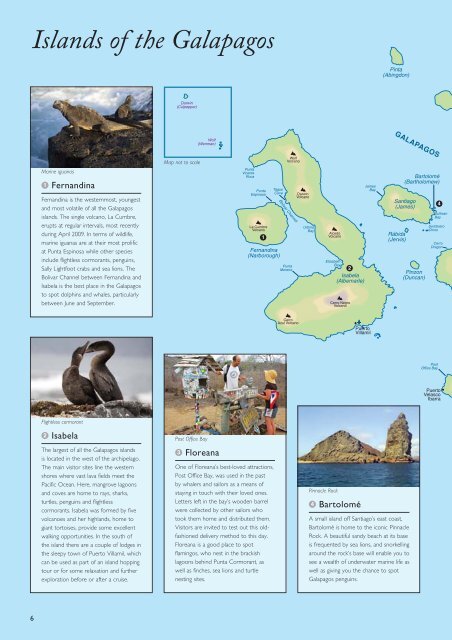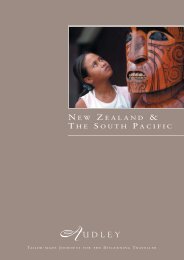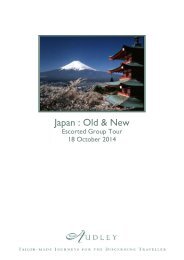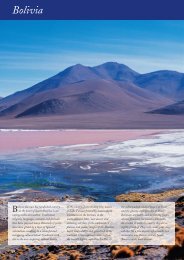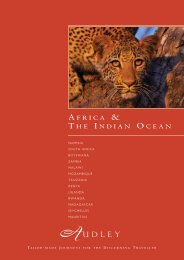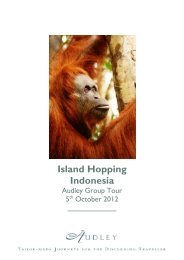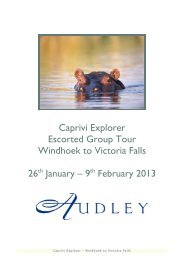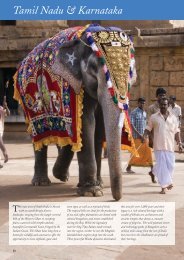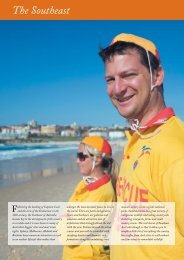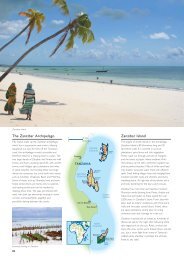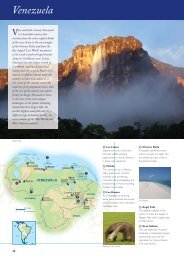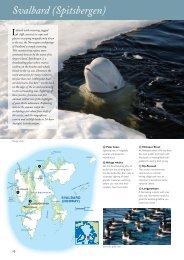Galapagos brochure.qxd:Audley brochure ... - Audley Travel
Galapagos brochure.qxd:Audley brochure ... - Audley Travel
Galapagos brochure.qxd:Audley brochure ... - Audley Travel
Create successful ePaper yourself
Turn your PDF publications into a flip-book with our unique Google optimized e-Paper software.
Islands of the <strong>Galapagos</strong><br />
Marine iguanas<br />
1<br />
Fernandina<br />
Map not to scale<br />
Fernandina is the westernmost, youngest<br />
and most volatile of all the <strong>Galapagos</strong><br />
islands. The single volcano, La Cumbre,<br />
erupts at regular intervals, most recently<br />
during April 2009. In terms of wildlife,<br />
marine iguanas are at their most prolific<br />
at Punta Espinosa while other species<br />
include flightless cormorants, penguins,<br />
Sally Lightfoot crabs and sea lions. The<br />
Bolivar Channel between Fernandina and<br />
Isabela is the best place in the <strong>Galapagos</strong><br />
to spot dolphins and whales, particularly<br />
between June and September.<br />
1<br />
2<br />
4<br />
Flightless cormorant<br />
2<br />
Isabela<br />
Post Office Bay<br />
The largest of all the <strong>Galapagos</strong> islands<br />
is located in the west of the archipelago.<br />
The main visitor sites line the western<br />
shores where vast lava fields meet the<br />
Pacific Ocean. Here, mangrove lagoons<br />
and coves are home to rays, sharks,<br />
turtles, penguins and flightless<br />
cormorants. Isabela was formed by five<br />
volcanoes and her highlands, home to<br />
giant tortoises, provide some excellent<br />
walking opportunities. In the south of<br />
the island there are a couple of lodges in<br />
the sleepy town of Puerto Villamil, which<br />
can be used as part of an island hopping<br />
tour or for some relaxation and further<br />
exploration before or after a cruise.<br />
3<br />
Floreana<br />
One of Floreana’s best-loved attractions,<br />
Post Office Bay, was used in the past<br />
by whalers and sailors as a means of<br />
staying in touch with their loved ones.<br />
Letters left in the bay’s wooden barrel<br />
were collected by other sailors who<br />
took them home and distributed them.<br />
Visitors are invited to test out this oldfashioned<br />
delivery method to this day.<br />
Floreana is a good place to spot<br />
flamingos, who nest in the brackish<br />
lagoons behind Punta Cormorant, as<br />
well as finches, sea lions and turtle<br />
nesting sites.<br />
Pinnacle Rock<br />
4<br />
Bartolomé<br />
A small island off Santiago’s east coast,<br />
Bartolomé is home to the iconic Pinnacle<br />
Rock. A beautiful sandy beach at its base<br />
is frequented by sea lions, and snorkelling<br />
around the rock’s base will enable you to<br />
see a wealth of underwater marine life as<br />
well as giving you the chance to spot<br />
<strong>Galapagos</strong> penguins.<br />
6
6<br />
5<br />
7<br />
Blue-footed boobies<br />
5<br />
North Seymour<br />
One of the richest central islands in<br />
terms of birdlife, with a large population<br />
of frigate birds, blue-footed boobies and<br />
gulls. North Seymour also has its own<br />
population of land iguanas and the<br />
western shores are home to sea lions<br />
and marine iguanas.<br />
Red-footed booby<br />
6<br />
Genovesa<br />
The sail into Darwin Bay on Genovesa<br />
is impressive, as it sits in a partially<br />
submerged volcanic caldera. The main<br />
attraction of the island is the red-footed<br />
booby, as this one of the few places in<br />
the <strong>Galapagos</strong> it can be seen. Other<br />
birds here include frigate birds, gulls,<br />
tropic birds, storm petrels and shorteared<br />
owls. Off the west coast of the<br />
island it is common to watch sea lions<br />
playing and surfing in the Pacific waves.<br />
3<br />
8<br />
Giant tortoise<br />
7<br />
Santa Cruz<br />
Waved albatross<br />
8<br />
Española<br />
In the far southeast of the archipelago,<br />
Española is the only island on which the<br />
waved albatross can be seen (between<br />
April and November). Punta Suárez is<br />
home to a variety of other birds<br />
including frigate birds, blue-footed and<br />
Nazca boobies, gulls and <strong>Galapagos</strong><br />
hawks, as well as giant tortoises and a<br />
unique species of marine iguana with its<br />
red and green colourings. At Gardner<br />
Bay, on the opposite side of the island,<br />
one of the archipelago's largest<br />
population of sea lions bask on the<br />
stunning white-sand beach.<br />
The highlands of Santa Cruz island<br />
provide a cool, lush retreat where giant<br />
tortoises can be seen in the wild,<br />
together with a variety of bird species.<br />
Along the northern shores of the island<br />
is Cerro Dragon, which is home to a<br />
number of land iguanas and Las Bachas<br />
beach, where Pacific green turtles lay<br />
their eggs annually. At Black Turtle Cove<br />
mangrove edged lagoons are home to<br />
turtles, rays and even sharks in the<br />
shallow waters. The most populated of<br />
all the <strong>Galapagos</strong> islands, Santa Cruz’s<br />
main town of Puerto Ayora has a<br />
number of hotels and is home to the<br />
Charles Darwin Research Station, the<br />
world renowned giant tortoise<br />
breeding centre.<br />
www.audleytravel.com/galapagos ● 01993 838 635 ● Islands of the <strong>Galapagos</strong> 7


